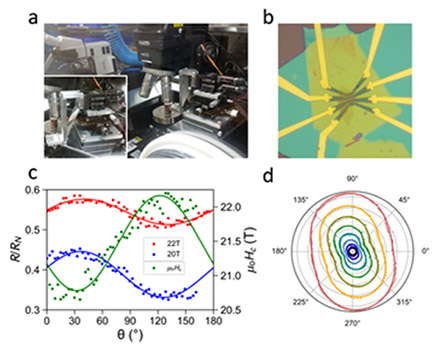
Transition metal dichalcogenides (TMDs), such as NbSe2, TaS2, and WTe2, are ideal material candidates for new types of unconventional superconductivity due to the presence of strong spin-orbit coupling in these atomically-thin materials, together with multi-pocket Fermi surfaces. This seed builds on work initiated by the PIs during an iSuperSeed award focused on superconductivity in few-layer TMD NbSe2, which opened up a number of exciting directions. Our theoretical study of the phase diagram of monolayer NbSe2 revealed two new types of topological superconducting phases: a nodal topological crystalline superconductor at large in-plane fields and small Rashba SOC, and a chiral topological superconductor at large Rashba SOC and small in-plane magnetic fields. Our experimental study instead uncovered an unexpected two-fold symmetry in the superconductivity of few-layer NbSe2 under a rotating in-plane B-field (see figure). This simultaneously provided clear evidence of an unconventional pairing mechanism, and raised fundamental questions about the origin of these pairing interactions.
This seed project leverages the experimental and theoretical toolkit we developed during the iSuperSeed to investigate several crucial open questions about superconductivity in few-layer NbSe2 and related 2D chalcogenide superconductors. First, the specific role of strain on the superconductivity of dichalcogenides, such as NbSe2, has remained unexplored. In order to shed light on the origin of the 2-fold symmetry, and search for the predicted 6-fold symmetry of the nodal superconducting phase, we will investigate the role of strain by taking advantage of our world-class capabilities to carefully align and engage few-layer crystals. In parallel, we will explore comprehensively the thickness dependence of the observed pairing mechanism, by measuring the way in which the tell-tale two-fold anisotropy evolves with number of layers.
UMN MRSEC
435 Amundson Hall, 421 Washington Ave. SE, Minneapolis, MN, 55455
P: 612-626-0713 | F: 612-626-7805